We mostly spend our time indoors at home, school, or work. Hence, we try to keep it clean and well-ventilated to have better health. However, air pollution exists in even the cleanest homes. Household air pollution negatively impacts an individual’s health and performance. Thus, know how poor indoor air quality affects individual’s performance.
Every year, indoor air pollution takes many lives. Since, as per data by WHO (World Health Organization), IAQ (Indoor Air quality) has caused an estimated 3.2 million deaths per year. With it, one more report by them shows that over 2.3 billion people use solid fuels for cooking in their houses. Hence, it emits various pollutants in the household.
Let us delve into indoor air pollution! Know about health issues, pollutants, and solutions to control pollution.
What is poor indoor air quality and its sources?
When dangerous pollutants are found in the air inside our indoor areas, it is referred to as indoor air pollution. We spend most of our time inside as in school, home, offices, or any other indoor space. Hence, it is detrimental for us to inhale these toxins. Thus, it is necessary to take steps to control and protect yourself from exposure. Let us know about the poor indoor air quality sources:
Home:
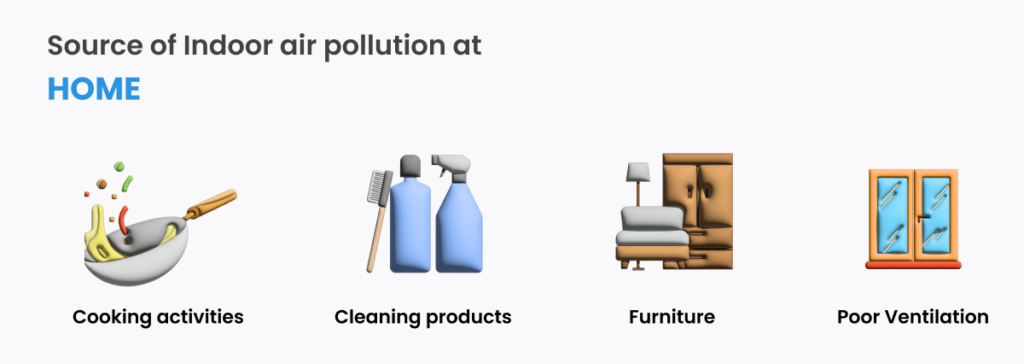
Offices:
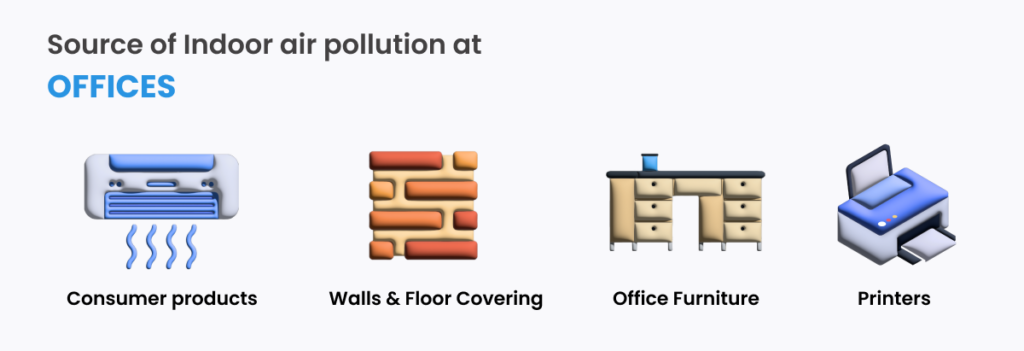
Schools

Here is the explanation for Indoor Air pollution sources:
1. Poor Ventilation:
Closing doors and windows capture the pollutants inside the room. It does not allow the fresh air to travel. The airborne pollutants cannot dilute and can store more humidity as well.
2. Tobacco smoke:
Many people smoke tobacco which leads to the release of harmful chemicals and toxins in the air. It risks the entire family’s health as they inhale the toxins.
3. Cleaning products:
Most cleaning products contain VOCs (Volatile Organic Compounds). It can cause health issues such as from allergies to extreme respiratory diseases. Cleaning products are used everywhere as in homes, schools, and offices.
4. Pesticides:
Pesticides release various harmful chemicals as hazardous air pollutants and TVOCs. Its exposure can lead to irritations or extreme health issues.
5. Furniture:
Furniture products furnishings require paints, glue resins, etc. It releases formaldehyde into the air. And it leads to various health issues. School tables and desks are a potential source of air pollution.
6. Building materials:
New construction and activities release air pollutants. Building materials including furniture, doors, textiles, paints, etc lead to the pollutants emission. Newly painted walls highly emit various pollutants in the air.
7. Appliances:
As heaters, charcoal grills emit toxic pollutants in the indoor air. Air conditioning systems also release CFCs which a very harmful gases. With it, printers are used in offices, schools, and homes.
8. Outdoor air pollution:
High outdoor pollution levels can affect indoor air quality. As it depends on the ventilation, temperature, and other factors.
9. Stationery:
Inhaling chalk dust can lead to various respiratory issues. With it, school Stationery like glues, adhesives, and other supplies releases VOC gases into the air.
What are the pollutants that affect an individual’s performance?

PM1, PM2.5, PM10:
Particulate Matters are the major pollutants present in indoor air quality. Since, these are the small particles of dust, dirt, smoke, etc. Besides, it emits from various sources as the fuel burning appliances.
TVOC
Various chemicals and scents emit VOCs (Volatile Organic Compounds) in the air. Moreover, VOC gases are toxic and lead to various health issues.
HCHO:
Formaldehyde is released from various sources. It is a colorless and flammable gas. Wooden furniture and painted walls release HCHO in the indoor environment.
CO:
Carbon Monoxide is a colorless and odorless gas. It is a dangerous gas that is released from fossil fuel emissions. Hence, cooking activities, and heating can release CO.
CO2
Carbon Dioxide is a major air pollutant because it is released from humans. It occurs due to less or poor ventilation in an indoor space. High CO2 level causes various health effects.
NO2
Nitrogen Dioxide is released when fossil fuels or natural gases are burned at a high temperature. IAQ affects individual’s performance because of high NO2 level in the air.
Ozone(O3)
Ozone is present in the atmosphere shielding us from harmful UV radiation. But ozone (O3) near humans is hazardous. It also releases from some home appliances. As from printers, some purifiers, and other devices.
Why healthy indoor air quality is necessary?
Indoor Air Quality is a concern for many people. But many people think that cleaning can help in improving indoor air quality. But it does not improve the air quality. Poor indoor air quality affects the health, comfort, performance, and well-being of an individual.

Improves thermal comfort:
The thermal comfort depends on the temperature, humidity, and air movement. Likewise, better indoor air quality helps in improving thermal comfort. Contrarily, a poor thermal environment can affect the well-being of an individual.
Improves individual productivity:
Good indoor air quality enhances the individual’s productivity. As it improves the concentration and activeness in their performances. The better air quality provides high productiveness.
Better health and well-being:
Harmful toxins can enter deep into the lungs and directly into the bloodstream. As a result, it can cause various health issues as heart-related problems. With it, clean air also works as mood enhancing.
Reduces the risks of the diseases:
Good indoor air quality enhances your health. Thus, lowering the pollution level can reduce your disease risk. Moreover, it decreases the overall risks of heart disease, strokes, lung cancers, and other health issues.
Know the poor indoor air quality effects on health:
The air quality inside your house is five times more polluted than the outside air. Thus, it highly impacts a person’s overall health because we spend most of our time indoors.
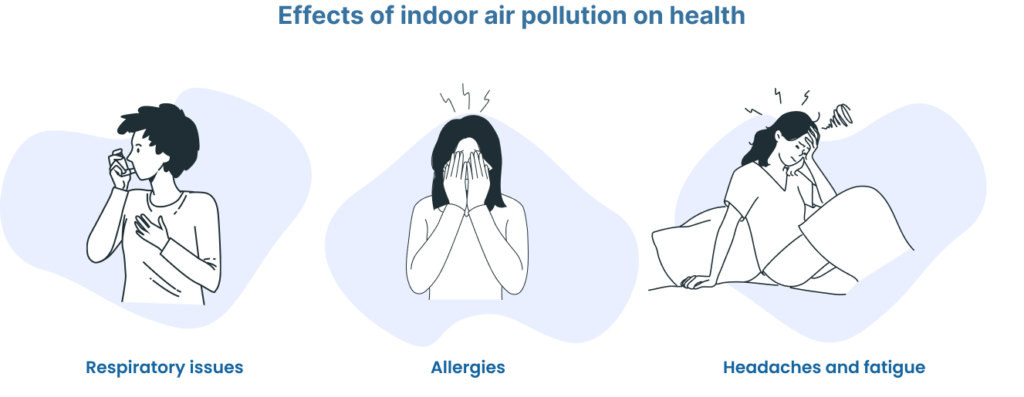
Respiratory problems:
Polluted air can cause various mild to major respiratory issues. Because air pollutant particles are much smaller in size and can easily travel deeply into the lungs. And it can exacerbate asthma, lung cancers, chronic obstructive pulmonary disease (COPD), and other respiratory problems.
Allergies:
Toxic air pollutants can make some symptoms worse in an individual with previous allergies. As they can have a runny, blocked nose, headaches, watery or eye itchiness, and allergic rhinitis.
Headaches and fatigue:
Poor indoor air quality can cause many health issues, such as headaches, fatigue, and other problems. Moreover, it causes sick building syndrome.
Poor indoor air quality impacts on cognitive function:
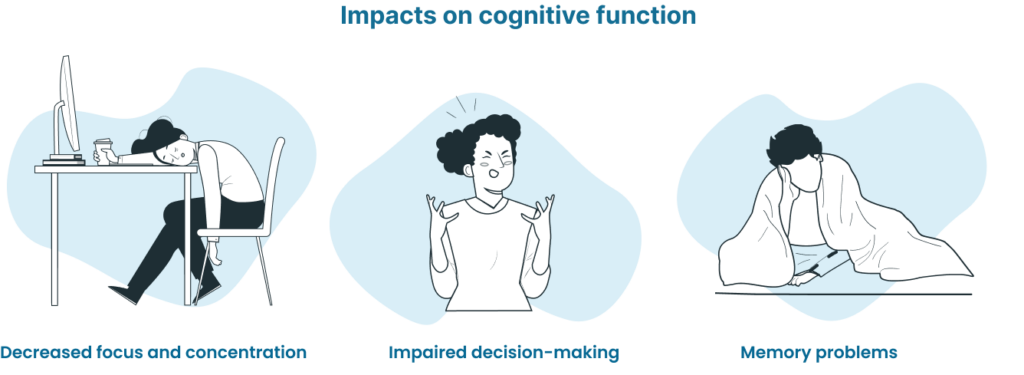
Decreased focus and concentration:
As per a report, a high level of CO2 in a room affects the individual’s focus and concentration. Impacted focus and concentration can decrease a person’s productivity in a task.
Impaired decision-making:
As it can impact your sleep cycle stress and comfort. Hence, you can face more problems in concentration and making a better decision at your workplace.
Memory problems:
It can impair the individual’s ability to think, work and learn. Long-term poor air quality exposure can lead to severe neurological disorders.
Indoor Air Quality influences on physical performance
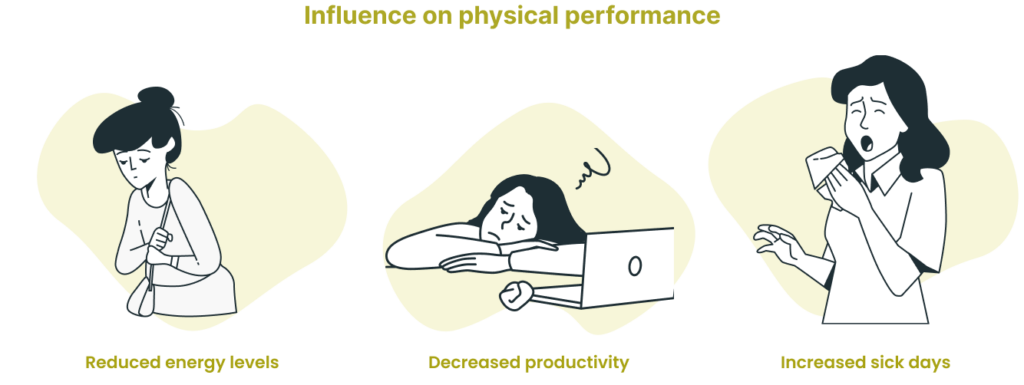
Reduced energy levels
Poor breathing or pollutant inhalation can affect the energy level. Indoor air quality has a high impact on any person’s physical health. As they can face fatigue, irritation, asthma, and headaches.
Decreased productivity
Pollutants in the air quality cause various health issues. These health issues lead to an impact on an individual’s productivity.
Increased sick days
Because it increases the chances of often allergies. With it, it also leads to sick building syndrome. Individuals can have ill feelings because of high exposure to poor air.
How to improve indoor air quality to increase individual performance?
Improving your indoor air quality can help boost your productivity and overall well-being. Some effective ways can help you in improving the air quality. It can help in your health and performance.
Improve your indoor air quality by considering the following tips:

Monitor air quality
Many cutting-edge air quality monitoring devices are available. These devices monitor the indoor air quality and provide real-time data. You can choose easily portable devices such as Cair+ or other indoor air quality monitors. Get real-time indoor air quality insight and make the best-informed decision.
Proper ventilation
Proper ventilation can help in decreasing the air pollutants present in the indoor space. It can be managed by installing the exhaust fan in polluted areas such as in the kitchen, bathroom, and other spaces.
Use of air purifiers:
High-tech air purifiers are the best investments to combat indoor air pollution. You can check for advanced air purifiers that include various pollutants like dust, pollen, and pet dander.
Regular cleaning and maintenance
You can improve the indoor air quality by regularly cleaning and dusting. With it, you can use natural cleaning products to avoid harmful chemicals.
Conclusion
In conclusion, protect yourselves from indoor air pollution effects. Monitor the air you breathe and make the best decision to control the pollutants. Takes some simple measures such as air purifier use, proper ventilation, and avoiding pollutant emission activities. It can help in improving indoor air quality for better performance and productivity.